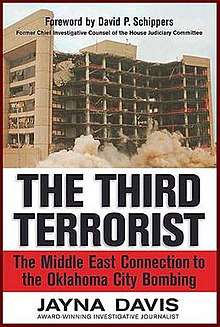The Third Terrorist
The Third Terrorist: The Middle East Connection to the Oklahoma City Bombing is a book by journalist Jayna Davis about evidence of an alleged conspiracy behind the 1995 Oklahoma City bombing. The Justice Department initially sought, but then abandoned its search for, a Middle East suspect. The book was published in April 2004 by Nelson Current Publishers, and became a New York Times best-seller. In contrast to conspiracy theories that the bombing was a false flag attack perpetrated by elements of the US government, the book presents a theory that links the Oklahoma City bombers to agents of Iraq and Al-Qaeda, operating under Iranian state sponsorship.
 | |
| Author | Jayna Davis |
|---|---|
| Language | English |
| Genre | Non-Fiction |
| Publisher | Thomas Nelson |
Publication date | March 8, 2005 |
| Pages | 384 |
| ISBN | 978-1-59555-014-9 |
Evidence and theory
Gathering the affidavits of twenty-two eyewitnesses and twenty-three hundred pages of corroborative documentation, the author theorizes that there was a third terrorist named Hussain Hashem Al-Hussaini, an Iraqi soldier in the first Gulf War, who was the "John Doe 2", who allegedly accompanied McVeigh to the Murrah Federal building in the ammonia nitrate fuel oil-ladened Ryder truck. The Federal Bureau of Investigation account of April 19, 1995 is that it was simply a domestic terrorism case, however Davis cites a CNN/USA Today poll that 68 percent of Americans believe other bombing conspirators are "still out there". Rep. Dana Rohrabacher (R-CA) visited Terry Nichols in prison in 2005 and Rohrabacher claims Nichols would not speculate about "John Doe 2" but claimed there were unknown others involved in the attack, a statement first made to the FBI during the investigation. Nichols stated his belief that the 1995 bombing that claimed the lives of 168 Americans was a "Middle Eastern" terrorist operation, however Nichols statements about events leading up to the attack are self-contradictory.[1] It was theorized that why Nichols would not implicate those involved by name was that he still has immediate and extended family members who could be targets of retaliation.
Chairman's Report Oversight and Investigations Subcommittee of the House International Relations Committee
Representative Dana Rohrabacher (R - CA) cited this research in the report "The Oklahoma City Bombing: Was There A Foreign Connection?" [2] Within the report the following statements citing several pieces of real and circumstantial evidence were made, supporting the main theory laid out by Jayna Davis in her book. "...of all the cities in the world, convicted terrorist Ramzi Yousef and Terry Nichols were in Cebu City in the Philippines at the same time three months before the Oklahoma City bombing. Yousef was the perpetrator of the first World Trade Center attack as well as the mastermind behind the planning of other high-profile attacks on Americans. Furthermore, Ramzi Yousef's phone records, from the months before he detonated the first World Trade Center bomb in early 1993, show calls placed to the Filipina neighbor and close friend of Terry Nichols' in-laws in Queens, New York. The opportunity for interaction between American terrorist, Nichols, and al-Qaeda terrorist, Yousef, is evident." [2]
"One indicator that this terrorist act had broader implications came directly from Abdul Hakim Murad, Yousef's roommate, childhood friend, and fellow convicted terrorist. On the day of the bombing, Murad claimed responsibility for this terrorist act from his jail cell in New York. He bragged to his prison guards, verbally and in writing, that the bombing of the Murrah federal building was the work of the "Liberation Army." His confession was similar to the one Yousef had made two years earlier in the immediate aftermath of the first attempt to destroy the World Trade Center. Hours after he drove a Ryder truck into the garage of the north tower of the World Trade Center and detonated the deadly bomb, Yousef called the FBI from a pay phone in Newark International Airport and boasted that the "Liberation Army" had conducted the attack. He then boarded a plane and escaped, ending up in Manila, Philippines. Note: the Oklahoma City Bombing followed a similar pattern to the 1993 attack on the World Trade Center —a rental truck loaded with ammonium-based explosives, using similar detonation devices, based on the strategy of driving a vehicle into or near a target." [2]
Another key piece of evidence that Jayna Davis used to build the case in her book for Middle Eastern involvement was the fact that Hussain Al-Hussaini "was one of a group of Iraqis hired to do odd jobs for a Palestinian landlord, Samir Khalil, who owned properties throughout the area. Khalil hired the Iraqi newcomers, supposedly refugees from the first Gulf War, to maintain his rental properties. Khalil himself served time for insurance fraud in the early 1990s. Hussaini resembles John Doe Two and was identified by witnesses on the scene." [2]
The connections by Davis in her book linking McVeigh to Murad, Yousef and the former Iraqi soldiers was made not only through Terry Nichols connection in the Philippines, but by the suspected John Doe 2, Hussain Al-Hussaini, to Samir Khalil who according to "the discovery of a published list of un-indicted coconspirators from the first World Trade Center bombing that includes the name Samir Khalil." [2]